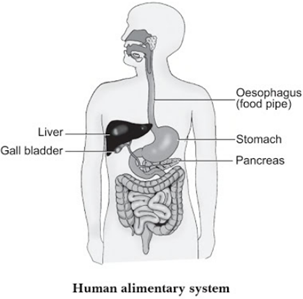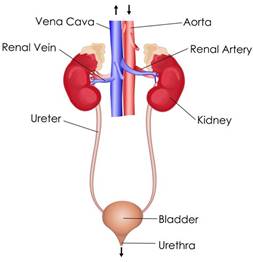Draw a diagram of the human alimentary canal and label on it:
Oesophagus, Gall bladder, Liver and Pancreas.
OR
Draw a diagram of the excretory system in human beings and label on it:
Aorta, vena cava, urinary bladder, urethra.
Human alimentary canal: The alimentary canal is a long tube extending from the mouth to the anus.
Oesophagus: From the mouth, the food is taken to the stomach through the food-pipe or oesophagus.
Gall bladder: It is located at below the liver. It stores the bile juice.
Pancreas: The pancreas secretes pancreatic juice which contains enzymes like trypsin for digesting proteins and lipase for breaking down emulsified fats.
Liver: It is very large gland and placed in the upper right side in the abdomen. It produces bile juice which is needed for the emulsification of fats.
OR
Excretory system: The excretory system includes the process of excretion. The biological process involved in the removal of these harmful metabolic wastes from the body is called excretion.
The excretory system of human beings includes a pair of kidneys, a pair of ureters, a urinary bladder and a urethra.
Aorta: It delivers the blood to the kidneys. Then this blood is filtered by the kidneys.
Vena Cava: It carries the deoxygenated blood.
Urinary bladder: It collects the waste excreted by the kidneys.
Urethra: It acts as the path between the urinary bladder and the external part of the body.

